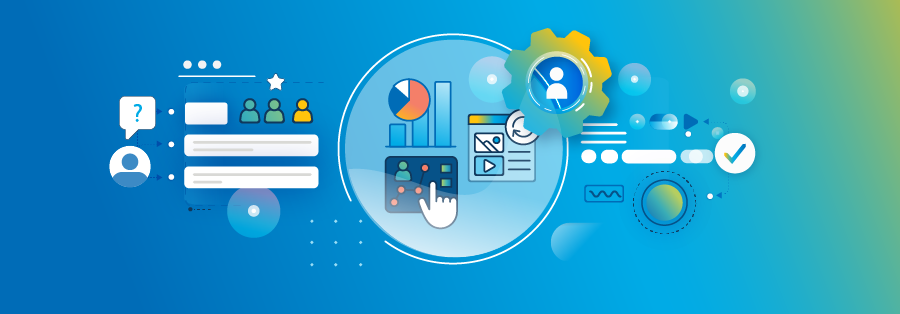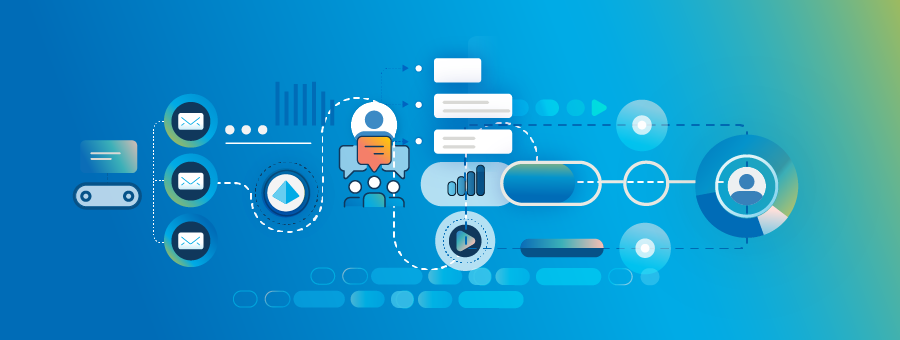Why and How to Use Customer Experience Automation

Improving the customer experience (CX) should be at the forefront of every organization’s goal, and automation can help improve customer satisfaction by eliminating errors, improving response times and communication, and providing personalized services.
What Is Customer Experience Automation?
Customer experience automation (CXA) is connected to robotic process automation (RPA), which automates routine tasks. It also extends beyond marketing automation and customer relationship management (CRM) because it automates the end-to-end customer journey, throughout the entire customer lifecycle.
Intelligent automation (IA) is the ideal solution for enhancing customer journeys. IA combines RPA task automation with artificial intelligence (AI) and business process management (BPM) to orchestrate interactions, streamline workflows and improve communication.
IA works with new or legacy systems and connects data points to provide a single source of truth. It can also be used to track buying patterns and deliver personalized communications to large audiences. With data-driven insights from BPM tools, you can better strategize your customer interactions so that every communication is purposeful and effective.
What’s the difference between CX automation and marketing automation?
CXA tools help organizations automate the entire customer journey, through initial engagement to the buying process and beyond.
Marketing automation doesn’t follow the customer lifecycle. Marketing automation is concerned with moving individuals through different stages of the campaign funnel.
What’s the difference between CX automation and CRM automation?
Customer relationship management (CRM) is the process of organizing and managing customer relationships and analyzing the data from those interactions. While CRM automation tools can work well with CXA tools, on its own, CRM doesn’t look at the entire customer lifecycle.
How does automation affect customer experience?
CX automation aims to improve the customer experience and free employees from tedious work. It allows businesses to automate one-on-one customer engagement, so communication efforts are timely and more personalized. This minimizes the need for manual human interaction and frees your team to focus on more specialized or complex customer queries.
How does automation improve customer experience?
Ideally, CX automation should help create a higher-quality, more consistent and available experience for customers across all channels – web, social, sales, etc. It’s not just about the buying experience, either. It’s about giving customers a seamlessly good experience all the way through their customer journey.
What are the Benefits of Customer Experience Automation?

CXA enhances the customer journey to improve customer engagement and give organizations a competitive advantage. And customer experience automation doesn’t just benefit your customers – it also helps your teams, from contact centers to sales and marketing, and even IT.
While there are many varieties of automation tools, let’s look at six benefits that most will offer:
24/7 Customer support
AI chatbots can handle common issues and customer queries that don’t require human interaction. This gives your customer an accurate answer right away, rather than waiting for an agent to respond. It also means your teams don’t have to be accessible at all hours of the night and day. Chatbots are always online and can flag outstanding issues if they require escalation to a human agent.
Automation tools can also provide self-service tools to customers, allowing them to check an order status, ask about a specific product, or fill out a questionnaire to validate their eligibility for a particular service.
Cost savings and profitability
CX automation helps minimize operational costs by reducing the number of tedious or repetitive requests for your human agents. These tasks can include data entry, basic customer support, and appointment scheduling. That means your team can focus on value-adding or profit-driving tasks, and your customers will get flexibility when accessing your products or services.
CXA analyzes customer behavior to suggest relevant products or services, which increases upselling and cross-selling potential. Delivering a better customer experience ensures customers are satisfied, which can boost conversions and revenue.
Customer satisfaction and loyalty
A seamless customer journey comes when customers get timely and personalized experiences. And happy customers are more likely to become repeat buyers or brand advocates. Automation ensures you’re consistently meeting your customer’s expectations.
CXA also allows you to develop targeted customer retention campaigns to develop customer loyalty and brand recognition.
Personalized services
CXA tools often collect and analyze data on customer interactions. This data provides valuable insights into customer feedback and pain points to help you make more informed decisions and improve your services.
Automation can also tailor customer interactions and recommendations based on their behavioral data, so they’re only getting information relevant to them. This could be with targeted ads or product recommendations. By engaging through multiple channels like email, chatbots, social media, etc., you can stay connected with your customers when and where they’re most active.
Employee satisfaction
CXA ensures your human agents have time to focus on more interesting, fulfilling, or demanding tasks rather than simple, repetitive work. With a centralized platform of customer data, your customer service agents can access relevant data or contact history in real-time to ensure customers are getting the best service possible — without repeat answers.
CX automation software can help your people better understand what your customers want and need, giving them more confidence in helping customers and making informed decisions.
Consistency
Automation streamlines customer communication and reduces friction for your customer by ensuring that every interaction follows a predefined process. It maintains consistent quality, which helps build trust and offer what customers expect.
Automation also helps minimize processing errors that may make your organization appear disorganized and unprofessional, even reducing some errors that drive away existing and prospective customers.
What Is an Example of Customer Experience Automation?

Let’s say you’re running an e-commerce website, and you have a customer wanting the status of her recent order. We’ll call her Naomi.
Here are the CX automation processes Naomi will go through:
Initial interaction
Naomi opens the website’s chat box, which initiates a chat. She types her question.
“Hi, I’d like to know the status of my order.”
Chatbot engagement
An AI-powered chatbot jumps on the screen and sends an immediate response to Naomi’s query.
“Hello, Naomi!” (Yes, the chatbot can personalize its response if Naomi is signed into her account). “I can help you with your order. Please provide your order number so I can better assist you.”
Information gathering
Naomi has her order number on hand and types it in.
The chatbot uses natural language processing (NLP) to understand the input and extract the relevant information.
Order status retrieval
The chatbot accesses your system’s database and retrieves the status associated with the provided order number. So long as the number is correct, the bot retrieves this information at lightning speed.
Response
Before Naomi can take a sip of coffee (two sugars, no cream), the chatbot’s already responding.
“Your order is out for delivery and should arrive by Friday.”
Follow-up assistance
In case Naomi has any further requests or queries, the chatbot can continue the conversation or even suggest related products.
“Is there anything else I can assist you with?”
Optional: Customer feedback survey
When Naomi has no further questions and closes the conversation, you can set up an automated feedback survey asking her to rate her experience.
Optional: Escalation
Okay, now let’s say Naomi doesn’t have her order number, and the chatbot can’t retrieve the number for some reason, or her order was damaged during delivery, and she has follow-up questions. In more complex circumstances, Naomi’s issue will be escalated to a customer service agent. The chatbot will hand off her request to a person equipped to help in more nuanced situations.
How can you use customer experience automation?

Automation isn’t about removing humans from the equation. It’s about enhancing work by letting digital workers do boring tasks while humans think and innovate. When it comes down to it, having a customer-centric approach to your automation benefits your customers, employees, and your organization’s profitability. That’s what we like to call a win-win-win!
Here are some examples of how you can use CX automation:
- AI chatbots: Chatbots can answer frequently asked questions in real time, so users don’t have to wait around for a customer service agent to become available.
- Automated emails: There’s a range of automated emails you can set up to increase customer retention. Set up automated communications for customers who have abandoned their cart, are newly subscribed, or need an order confirmation or account activity updates.
- Feedback surveys: Automate customer surveys to ask them about their most recent interaction or purchase with your brand and use that data to see where you can improve.
- Self-service scheduling: Customers don’t have to call in and talk to a human. With self-service tools, they can schedule their own appointments and then receive an automated confirmation of their booking.
- Live chat: Let’s say your customer has a more complex query that a chatbot can’t answer. With live chat, your customers can speak to an agent without sitting on hold with their phone pressed to their ear for hours. Live chat also allows customer service representatives to organize and resolve requests more easily.
Automation is accurate, fast, and secure – qualities that will help you build better customer journeys with better service, optimized processes, and more personalized campaigns.
SS&C Blue Prism provides a robust, secure, and efficient intelligent automation platform. Contact us to see how automation can transform your customer interactions.